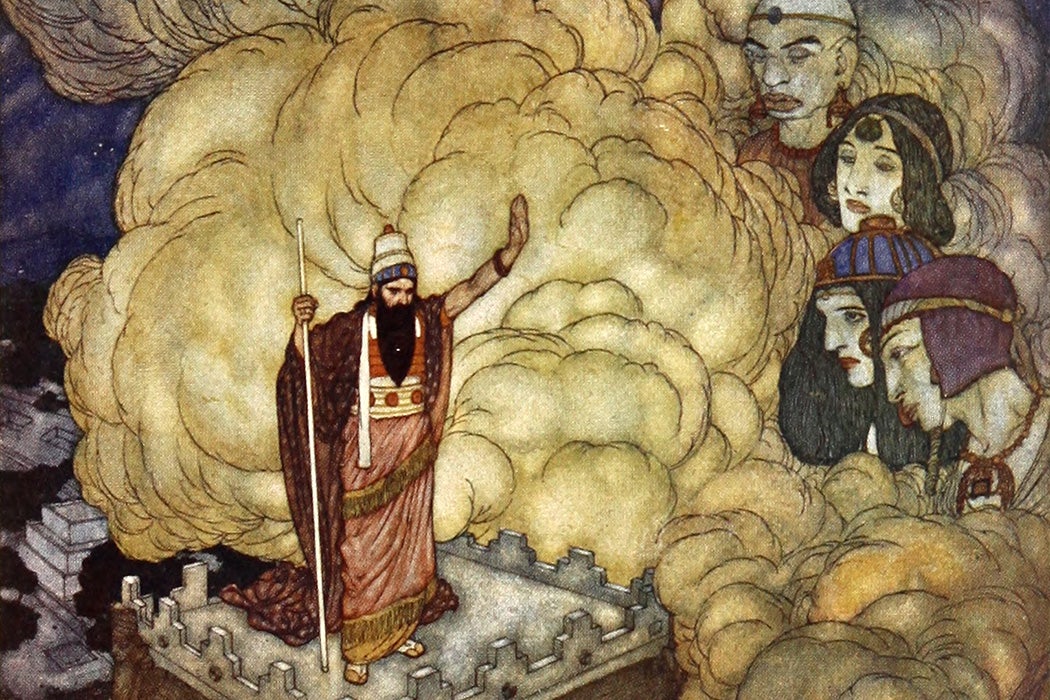Aladdin of the wonderful lamp and Sinbad the adventurous sailor might seem like unlikely American icons, but that’s how they were often viewed before the Civil War. As the American Quarterly Review put it in 1829, “We consider them as powerful delineations of national character, seen through a veil of delicately wrought fiction.” They meant American “national character.”
Scholar Rasoul Aliakbari explores the antebellum US’s fascination with the one thousand and one Arabian Nights stories of life-changing voyages, enriching adventures, and surprising transformations, all of which “nourished the new nation’s aspirations and growing subjectivity.” As Aliakbari explains, American publishers “brought over the already international Nights and took the imagery, settings, and characters that they required to imagine the American entrepreneurial character and its promise of affluence.”
The first known American edition of the Arabian Nights was published in Philadelphia in 1794. Before the Civil War, there were at least sixty editions of the Nights, in addition to numerous standalone publications of the Aladdin, Ali Baba, and Sinbad stories. There were also anthologies: Sinbad featured in the purported adventures of Baron Munchausen in 1817; Sinbad and Aladdin were included in the 1860 The Child’s Own Book of Standard Fairy Tales, alongside Cinderella, Beauty and the Beast, and Little Red Riding Hood.
Theaters and circuses were other venues for the Nights. The story of Ali Baba and the Forty Thieves was first published on its own as a dramatic adaptation: The Forty Thieves: A Grand Romantic Drama, in Two Acts (1808). Copyright being hazy, there was also The Forty Thieves: A Grand Operatical Romance, in Two Acts (1809) and, what must have been the best yet, The Forty Thieves: A Grand Operatical Romance, and Brilliant Spectacle, in Two Acts (1810).
Through an Orientalist mirror, Americans envisioned attaining wealth and luxurious abundance in such rags-to-riches fantasies. These were fairy tales for a vigorous, expanding, mostly rural people insecure about their place in the world and on the continent. (In the early twentieth century, such rags-to-riches fantasies would be modernized, Americanized, urbanized, and called, rather perversely, “Horatio Alger stories.”)
The exotic adventures in Nights “paralleled contemporary experiences of socioeconomic transformation,” writes Aliakbari. Sinbad was enlisted in narratives of territorial expansion, as during the annexation of Mexican lands in the Mexican-American War (1846–1848). The California Gold Rush (1848–1855), as another example, turned Aladdin into “a fitting metaphor for the fortune seeker” in the west. Meanwhile, Sinbad, Robinson Crusoe, and Lemuel Gulliver could all be called upon to boost one’s self esteem (self-help isn’t an invention of the 1970s!)
Weekly Newsletter
The economic and social transformations of rapid industrial development were even understood within the context of the transformations in the Nights. In the stories, these were usually supernatural transmutations, and hey presto! Aladdin’s lamp became a metaphor for scientific advancement. The wondrous Crystal Palace of the 1851 Great Exhibition in London was previewed by a Philadelphia paper in terms people might better understand: it was like the glass castle whipped up by the genie of Aladdin’s lamp. The Bangor Daily Whig and Courier declared in 1860:
We are able to accomplish many things, now-a-days, which have a parallel only in the enchantments of the genie of the “Arabian Nights”; and indeed, to the unlearned eye, some laboratory experiments appear something more than marvelous.
American popular culture reveled in the “elaborate and excessive fantasies” of the Nights. The “consumption of Orientalia and other colonial goods,” a marker of elite status, added a cultural overlay of affluence—actual or aspirational—to the stories’ American reception.
Americans undoubtedly used the Arabian Nights to interpret the region now called the Middle East. But perhaps more importantly, the Nights were fully Americanized into an emerging definition of Americans as “risk taking, capitalist, and consumerist.” Not to mention hedonistic, if you had the gold sequins to pay for such a lifestyle—or a genie to make it all happen like magic.







